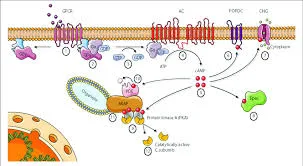Unveiling the Cyclic AMP Pathway: A Central Player in Cellular Communication
- Get link
- X
- Other Apps
In the realm of cellular communication, the cyclic AMP (cAMP) pathway stands out as one of the most crucial signaling mechanisms. It plays a vital role in transmitting signals from extracellular stimuli to intracellular actions, thereby orchestrating numerous physiological responses. This blog post delves into the intricacies of the cAMP pathway, exploring its components, functions, and significance in health and disease.
What is the Cyclic AMP Pathway?
The cAMP pathway is a signal transduction pathway that relies on the second messenger cyclic adenosine monophosphate (cAMP) to relay signals from cell surface receptors to internal cellular targets. This pathway is fundamental in regulating various physiological processes, including metabolism, gene expression, and cell growth.
Key Components of the cAMP Pathway
G-Protein-Coupled Receptors (GPCRs): The journey begins when a signaling molecule, such as a hormone or neurotransmitter, binds to a GPCR on the cell surface. GPCRs are a large family of receptors that detect extracellular signals and activate intracellular signaling cascades.
G Proteins: Upon activation by a GPCR, a G protein, specifically the Gs (stimulatory) type, is activated. G proteins are molecular switches that convey signals from receptors to downstream effectors.
Adenylate Cyclase: The activated Gs protein stimulates adenylate cyclase, an enzyme embedded in the cell membrane. Adenylate cyclase catalyzes the conversion of ATP to cAMP, the pivotal second messenger in this pathway.
cAMP: Once produced, cAMP diffuses within the cell to activate protein kinase A (PKA) and other downstream effectors. The rise in cAMP levels is a crucial step in the signal transduction process.
Protein Kinase A (PKA): PKA is a key enzyme activated by cAMP. It phosphorylates various target proteins, thereby modulating their activity. This phosphorylation event leads to a wide array of cellular responses.
Phosphodiesterases (PDEs): To terminate the signal, PDEs degrade cAMP into AMP, ensuring that the signal is transient and tightly regulated.
Functions of the cAMP Pathway
The cAMP pathway influences numerous physiological processes, including:
- Metabolic Regulation: cAMP regulates glycogen breakdown in the liver by activating enzymes involved in glycogenolysis, providing glucose during fasting or stress.
- Gene Expression: Through PKA, cAMP influences gene transcription by activating transcription factors such as CREB (cAMP response element-binding protein), which binds to DNA and modulates gene expression.
- Hormonal Responses: Many hormones, including adrenaline and glucagon, utilize the cAMP pathway to elicit their effects, such as increasing heart rate and promoting gluconeogenesis.
- Neuronal Signaling: In neurons, cAMP plays a role in synaptic plasticity, learning, and memory by modulating neurotransmitter release and receptor sensitivity.
Clinical Implications
Dysregulation of the cAMP pathway is associated with various diseases, highlighting its importance in maintaining cellular function and overall health. Some clinical implications include:
- Endocrine Disorders: Abnormal cAMP signaling can lead to conditions such as hyperthyroidism or Cushing's syndrome, where hormone production is dysregulated.
- Heart Disease: Since cAMP affects heart rate and contractility, disruptions in this pathway can contribute to cardiac conditions like heart failure.
- Neuropsychiatric Disorders: Altered cAMP signaling is implicated in depression and cognitive impairments, as it affects neurotransmission and neural plasticity.
- Cancer: Aberrant cAMP signaling can influence cell proliferation and survival, playing a role in tumorigenesis.
Therapeutic Interventions
Targeting the cAMP pathway offers potential therapeutic avenues for various diseases. For instance:
- Beta-Blockers: These drugs inhibit the effects of adrenaline on GPCRs, thereby reducing cAMP levels and lowering blood pressure and heart rate in hypertensive patients.
- PDE Inhibitors: By preventing the degradation of cAMP, PDE inhibitors enhance cAMP signaling. These are used in treating conditions like chronic obstructive pulmonary disease (COPD) and erectile dysfunction.
Conclusion
The cyclic AMP pathway is a cornerstone of cellular signaling, pivotal in translating extracellular signals into appropriate cellular responses. Its broad influence on metabolism, gene expression, and physiological functions underscores its importance in health and disease. Understanding the cAMP pathway not only provides insight into fundamental biological processes but also opens up possibilities for targeted therapeutic interventions in various medical conditions. Through continued research, we can further unravel the complexities of this pathway and harness its potential in advancing medical science.
- Get link
- X
- Other Apps

Comments